'I live in the space between chaos and shape. I walk the line that continually threatens to lose its tautness under me, dropping me into the dark pit where there is no meaning. At other times the line is so wired that it lights up the soles of my feet, gradually my whole body, until I am my own beacon, and I see then the beauty of newly created worlds, a form that it is not random. A new beginning.'
Jeanette Winterson, The World and Other Places
I grew up in sub-tropical Brisbane, Queensland. Like most kids in the 1960’s and 70’s I roamed freely. One of my favourite places to go was the local cemetery. It shimmered in the humid air and was full of the vibrant purples and oranges of jacaranda and poinciana trees. The cemetery was reliably full of the Beautiful and Mysterious - statues of angels and strange curlicues of the funerary and monument-making trade - and for me a fascinating, picturesque place to lose myself in.
Other measureless afternoons were spent in the park directly opposite our home that sat high on a rock cutting above a main road. The sound of my older sister playing Chopin or Rachmaninoff cascaded down our many front steps, over the road and down the park’s steep embankment…. I’m standing bare-footed and stock-still in a moat of gravelly sand, head slightly turned, listening : it’s as if the music comes from the trees and the light. Then with a short run I lift my feet - airborne! - clutching for dear life the metal rings at the ends of thick chains fixed to a pole high above my head, flying round and around and around with my shadow-companion through air the colour of a ripe mango. Later, having exhausted all other adventures, I lie face down on the slippery slide putting my tongue to the warm steel. Tasting summer.
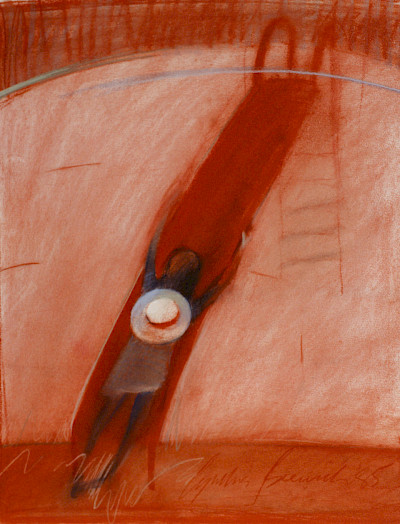
Schoolgirl Series, 1986
I can’t ever remember a time I wasn’t drawing and painting. Our household was a very creative one. My parents had a passion for classical music (especially the Romantic composers) as well as opera. There was music of the times we enjoyed too, like Frank Sinatra, Burt Bacharach and Dione Warwick, Simon and Garfunkel, Petula Clark, Carol King, Roberta Flack… there was always music in the background.
I loved rainy weekends the best: I’d be at the sunroom table drawing, my mother would be sewing with my sister (who would one day have her own boutique, fashion label and a book published on children’s clothing), and my older sister would be practicing the piano (she would go on to win a scholarship to study piano in Germany becoming a performer, music educator and author on performance enhancement). We were together but each in our own worlds.
The sister who sewed also played folk guitar and sang, and so did some of her friends, and I’d make ink drawings of them while they jammed. One of her friends loved to take these and put them on his wall.
At different stages the 8 and 10 year difference between myself and my siblings was enough for me to feel like an ‘only’ child - that is to say ‘solitary’; I never felt lonely. From when I’m about 5 I know I quite like being alone and begin to recognise how much I enjoy thinking,too, sitting up in the giant mango tree in our backyard. I notice everything around me. Its canopy goes down almost to the ground like a tent giving a greenish glow, birds come and go, I watch the skinks and frilled lizards below, invisible to grownups. I feel completely blended into the tree, at one with it and all the creatures it houses, along with the sweet-and-sour scent of decaying mangoes and the interesting mosaic shapes and colours of leaves, shadows and light. This is a blissful multi-layered feeling: aural, visual and olfactory. It is my first conscious recognition of nature. I revel in the privacy of it and the enjoyment of solitude. I’ve also discovered a palace of rooms inside me along with an intriguing other inner voice I can commune with and be entertained by. All this is outside of time. My parallel world has already begun.
My mother was an artist. She painted in our sunroom. Sometimes she used the old shed down past the incinerator and the mulberry tree but she preferred the abundance of more even light in the sunroom.
Her first teacher was Melville Haysom, an Australian artist, sculptor, art teacher and musician. He and his wife Yvonne were avid encouragers of the Brisbane art community who met together regularly at their home, Haysom’s farm, in the foothills of Mount Coot-tha; his works now reside in the Qld Art Gallery, the National Gallery of Australia, and the Art Gallery of New South Wales. Later she studied with another notable local Brisbane artist of the time, David Fowler.
A painting would be worked up from sketches she made outdoors, mostly in the company of her small painters’ group. It was often a river or beach scene, or a beloved subject of hers, jacaranda trees, though she also painted still life and our cats. Sometimes she participated in group exhibitions and entered art competitions, framing the work herself (she was good at carpentry), and was quietly elated whenever she made a sale.
I’d often arrive home to find her leaning over a small kingdom of tubes of oil paint, a paint box, brushes, palette, jam jars of turpentine, palette knife in hand - all concentration in a striped sundress, oblivious to housework, a painting in progress.
She didn’t paint every day but when she did she was careful to finish up by the time school was let out, had everything tidied away. The evidence was propped up on the ledge between the sunroom and kitchen where it stayed for a day or two to be judged by her own critical eye, and so that my father would see it and comment on it when he arrived home from the business world. We all commented.
Being an artist myself I appreciate now how frustrating it must have been for her to tear herself away from that stolen hour or two to accommodate me, and usually a companion in tow. Sometimes she did lose track of time and whoever was traipsing in with me would be astonished to see someone in the act of painting a picture. I was surprised they were surprised - I’d assumed all mothers painted. It never occurred to me she was ‘an artist’. It was simply part of her, just there, like her ability to sew or bodysurf. As I grew older I came to understand it was a powerful part of her : her liquid brown eyes possessed flashes of something privately meaningful and exhilarating to her, aside from the person I knew as ‘my mother’.
I grew up with a Renoir, a Vermeer and a Degas on our walls. Not the real thing but quality facsimiles. Original paintings joined them as money allowed, my parents purchasing from Royal Queensland Art Society exhibitions, or sometimes from my mother’s painting teachers, as well as various commercial galleries. These acquisitions weren’t terribly costly but they were a deliberate channelling of funds that could easily have been spent on other things.
I made surveys and contemplations of these pictures on my travels in the various territories of our house. Their colours, styles and imagined realities beckoned to me like windows onto something just as surely as the windows of the house brought the outside in. They were other worlds I could climb into mentally.
I also became aware that having art on our walls - let alone painting pictures yourself - was not that common in 1960’s and 70’s suburban Australia. While I took it for granted then, my parents were showing us by example that art was important. That making and collecting art - and discussing and looking at art - were worthwhile activities and that these things enriched daily life and gave it added meaning.
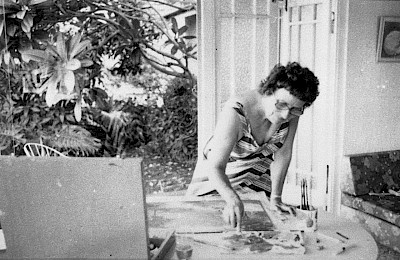
My mother, Noela Breusch, painting in the sunroom.
At age 13-14, I began studying the clarinet after school as an external student at the Queensland Conservatorium of Music with the then First Clarinetist of the Qld Symphony Orchestra, David Shephard. I continued by private tuition with Barbara Lockwood who encouraged me to play in local recitals. With a jazz teacher I also learnt how to improvise and to compose and write down my own small compositions, which were set as weekly creative exercises. I loved playing in the school orchestra and in a chamber music group, too, for that special ‘telepathic’ communication that happens between ensemble players.
Looking back the discipline of learning music stood me in good stead for the focus necessary for being in the studio every day. And over the years my love of music has found its way into my artwork. This is overtly as themes and motifs but also in more esoteric ways : in seeking a ‘musical’ feeling of balance to a visual composition as well as a certain rhythm to the brush marks which suits whatever I’m portraying. I’m also aiming to capture something of the transcendent the way that music can. Painting, like music, is a language of flight and feeling for me.
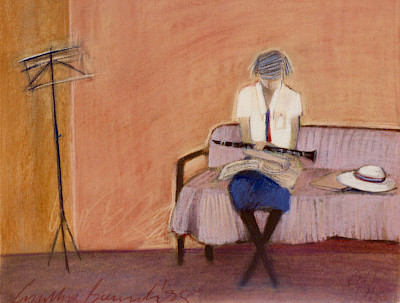
Schoolgirl Series, 1986
At 15 I saw first hand that the world was full of art. I had the great fortune to accompany my parents on a trip through Europe. This was something long dreamed of and planned for, now galvanised by my older sister getting married and settling in Germany. It would be my mother’s first overseas trip and my father’s first return to Europe since he’d served as a Lancaster pilot in World War II.
So many kids travel internationally now but it wasn’t so common in 1974. I was taken out of school for 9 weeks. The three of us travelled by train through the UK, France, Belgium, the Netherlands, Germany, Switzerland, Austria, Italy, Denmark (where we researched our family history), Norway and Sweden. A large part of that experience was visiting art museums, commercial art galleries and sculpture gardens, as well as West End theatre and a performance of Aida staged in the almost 2,000 year-old Arena de Verona.
This exploded my world view - the walls flew off! Not only did it light a fire for travel but it expanded my inner vision too. I felt very different on my return to school. I regard this trip as one of the greatest things my parents ever did for me.

Aged 15 at Millesgårten Museum on the island of Lindigö, Stockholm
At 16 I made my first formal art sale in a fundraising exhibition held by the then nascent Zonta Club of Brisbane Inc., (still going strong today), part of a global not-for-profit organisation that empowers women and girls through service and advocacy.
I’d been drawing obsessively, for quite a while using nibs and ink on paper. These drawings were influenced by my passion for the the Brothers’ Grimm and Hans Christian Andersen fairytales I had as a child. I especially loved those illustrated by Arthur Rackham, and a little later the work of Aubrey Beardsley; the fundraiser piece drew on that type of expression. I can still recall the tremendous thrill that someone wanted to live with what I’d dreamed up! This feeling has never left me; I’m still the same when anything is purchased, or just admired - the magic that it is to connect with others through my work.
By the time I finished high school I was determined to be an illustrator because of those childhood books. I chose to do a Diploma in Visual Communication (Graphic Design) at the Qld College of Art (now Qld College of Art and Design, Griffith University), majoring in Illustration. I figured I could earn a living while developing my fine art on the side, which I was also keen to do; both pursuits were important to me then. But I never thought past this that I might one day make my fine art my sole occupation. I was fizzing with curiosity and just wanted to get on and explore everything I could about Design and Art.
In the first year of the course we could take subjects from both the Design and Fine Art faculties. I found this very beneficial : I learned how to use so many different types of media and developed critical thinking from a variety of lecturers, all great practitioners in their fields, the very best of them never trying to make our work over into the kind of work they themselves did but encouraging what was unique to each of us.
Graphic design gave me a sound grounding in compositional form which is necessary to painting as well. The course’s emphasis on life drawing not only honed my observational powers but also developed my visual memory of the human body. Over time I’ve accrued a great mental storehouse of the figure in all kinds of postures which is a very useful adjunct to sketches and photographic material allowing me to work instinctively.
Flaming with impatience and hungry for experience I ventured into freelancing during the final year of my studies : graphic design jobs, set designs for television, textile designs for a fabric company, and illustrations for several publishers.
The University of Queensland Press was one of those publishers and one of my graphic design lecturers, Christopher McVinish, was freelancing for them. One day he asked me if I’d like to do an illustration for the cover of a collection of poetry he was designing. This would prove to be a fateful project. Not only would it become the first of hundreds of book jackets we would go on to do in tandem over the following decade but he and I would marry a year after my graduation.
Also during that final year I had my first experience of exhibiting professionally in a two-person exhibition at the Paddington Gallery, in Brisbane. I made a collection that included pastel, ink, and collage/mixed media works on paper. My first solo exhibition would be held the following year in the same gallery.
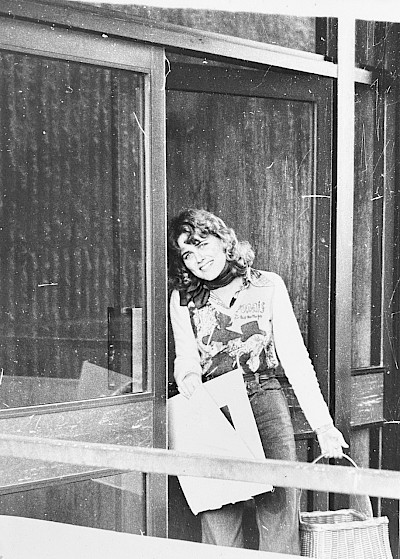
College days
The 1980’s was a hectic but exciting decade of creative endeavour where it seemed like I lived many lives all at once.
Christopher and I designed and illustrated book jackets for the University of Queensland Press’ Fiction, Non-Fiction, Poetry and Young Adult Fiction titles. Our work steadily appeared on the covers of many of Australia’s best loved authors such as Kate Grenville, Peter Carey, David Malouf and Olga Masters, with some authors at the beginning of what would become stellar writing careers. We also created covers for the Literary Journals Imago - New Writing, and the multicultural Outrider - Contemporary Australian Literature. These often featured artworks from regular art exhibitions I’d been having, making for rewarding cross-fertilisation. We won many state and national industry awards along the way.
Alongside this freelance work I’d begun my more formal working life in advertising and design studios. Before long an intriguing-looking technician’s position came up at the Queensland Museum ( a natural history museum) which I successfully applied for and this took me into a distinctly different context of visual design.
I found myself hand painting replica casts of fish along with designing graphics for all sorts of museum requirements. Fairly soon I became one of their display designers, not something I’d ever imagined for myself in college days. It turned out that it was a unique and exciting time to be at the QM as they were to shift their 2 million-item collection to brand new premises, part of Brisbane's South Bank Cultural Centre on the river. We worked in teams and I was allocated three of their permanent public display spaces to design (the largest of which went on to win an Australian Museums Design Award). I also designed special event exhibitions and the museum's new corporate identity, (including their new logo which served them for nearly 20 years).
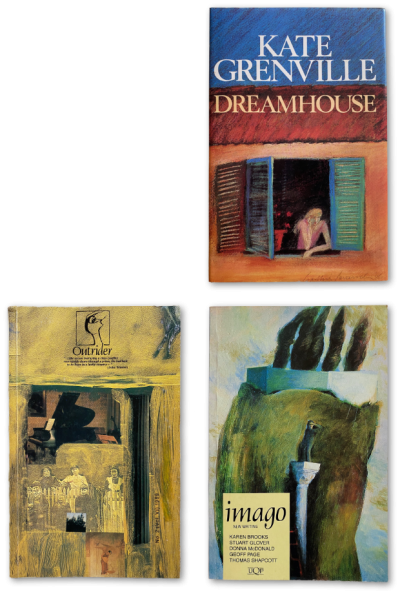
Towards the end of the 80’s Christopher had let go of lecturing to open his own design studio employing two other designers. It became a rapidly growing business and another designer was much needed so I left the QM. Over the next few years we gathered interstate as well as local clients and collected many industry design awards.
But in 1988 my world collapsed : my beloved mother died.
After a year of desolation from which I thought I’d never recover, I suddenly felt a powerful need to transform this into a celebration of my close relationship with her. The result became the consecutive exhibitions The Dream Series and In the Garden of Many Things, and my first foray into using oil pastel on paper. The work poured out of me - I couldn’t get it down fast enough! It was as if sheer thought made it materialise on the paper. These exhibitions were instrumental in my being represented by galleries in Sydney, Hobart and Melbourne.
Then, just over a year after my mother died, my father died suddenly. That my parents were no longer in the world was inconceivable, the loss profound. The pieces in the kaleidoscope had shifted in the most dramatic of ways. I was not yet 30. It changed my thinking entirely : there were no guarantees of a tomorrow - Life is finite! - for all of us.
I carried on as before but coming up with creative solutions for other people didn’t feel the same. I wasn’t the same. It felt like the end of something and the beginning of a need to deepen something else which had been advancing ever-closer anyway : my fine art had been garnering an ever-increasing following. I decided to ‘live immediately’ (Seneca) and to dedicate myself solely to my fine art practice and jettison the rest. That’s over 3 decades ago now.
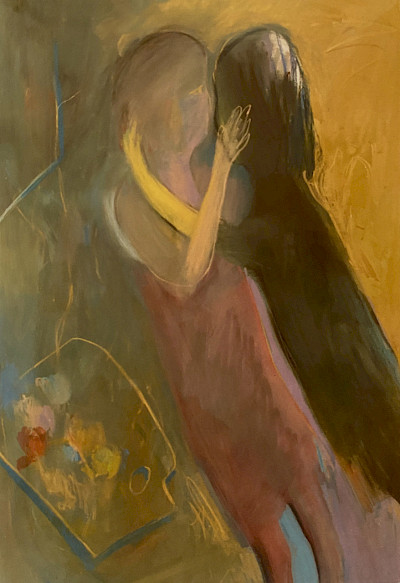
Dream Series, 1989
It’s difficult to describe something that happens intuitively but I like my paintings to have a bit of mystery or dreaminess to them.
I work in themes, some recurring in new ways. Over time these have encompassed figure-in-landscape (landscape as a stage setting or as emotional threshold); figure-in-interior (interior as dreaming room); and mixed-media/collage (where I reference the figure in art history or from vintage photography). Sometimes there are works which don’t have figures - perhaps only objects and/or trees - yet I think of these things as personages too.
Recurring motifs include ladders, pianos, spheres, comets, and messenger-foxes and owls which have great personal meaning for me. Whatever the motifs, the real subject is something else : hope, eternity, inner reflection.
Themes are used metaphorically to explore the relationship with the Self, as well as my belief in the ‘metaphysical amidst the every day’ and our human need for transcendent meaning beyond material reality. I’m especially interested in capturing the state of reverie, when time feels both stopped and unending.
Atmosphere, a resonance in an artwork, is what’s most valuable to me.
I want to paint invisible things! - things for which there are no words. It often feels like trying to pin down ether. I like to have areas of abstraction, as well, through the layering and scumbling of paint, which helps to carry this atmosphere.
There is no definitive plan when I brave the easel. A lot can change and happen along the way as I prowl around, darting back and forth. Useful accidents might result in new insights and directions that I’ve not thought of at the start (however, as a famous artist said, you need to be able to recognise they’re useful). The most satisfying works are the ones I can’t remember doing at all - I was ‘off-world’.
The jewell for me is the process: I love the fact I am a maker of things.
I never cease to marvel there is something at the end of the day that didn’t exist in the world that morning.
In many ways I’ve made a profession out of dreaming in the mango tree. To live a creative life is a great privilege. To borrow Virginia Woolf’s observation, “For me it has been an alternative imaginary life, consolation, freedom, escape.”
I came to live and work in the World Heritage area of the Blue Mountains, west of Sydney, via Brisbane, Hobart, and the hinterland of the Sunshine Coast, Queensland. I’ve now spent the majority of my life outside of cities, as Rainer Maria Rilke puts it, ‘away from the noise and applause of the city’.
There’s some mileage on my brush now. I have practical experience of certain things but essentially making art remains an engaging mystery to me. Every day is a wholly new beginning! : the potential for discovery, new ways of seeing, problems to solve. I like challenging myself, finding new and different pathways into my preoccupations, going ‘through the unknown, remembered gate’ (T.S. Eliot).
I feel the same way Barbara Hepworth did when she remarked : “When I look back on my work I feel that although it has changed and I have changed, the mood has remained the same.”
I like feeling part of a vast continuum of artists - especially women artists - from those stretching through the centuries to all of us working now and on to those yet to come, long into the future. Art is another definition of hope and renewal, never more so in times of tumultuous change and uncertainty.
Amidst the kind of lofty and insouciant declarations that 20-year old’s make, my graduation exhibition art statement reads ‘my biggest self-expectations are originality and sincerity’. Nothing has altered there.
A piece of me goes into everything I make.
And there is still ‘a lot in the melting pot’…
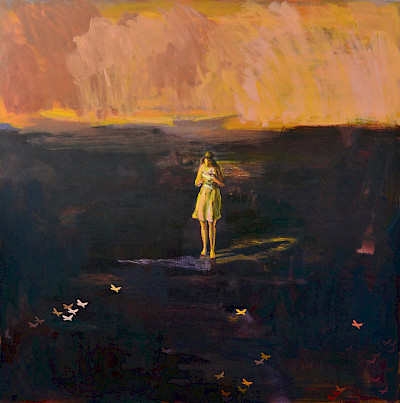
The Letter, 2022